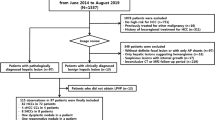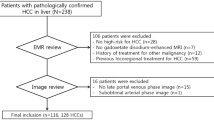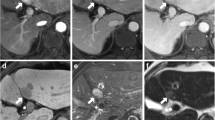Abstract
Objectives
To compare the diagnostic performances of first and second portal venous phases (PVP1 and PVP2) in revealing washout and capsule appearance for non-invasive HCC diagnoses in gadoxetic acid–enhanced MRI (Gd-EOB-MRI).
Methods
This retrospective study included 123 at-risk patients with 160 hepatic observations (HCCs, n = 116; non-HCC malignancies, n = 18; benign, n = 26) showing arterial phase hyper-enhancement (APHE) ≥ 1 cm at Gd-EOB-MRI. The mean time intervals from gadoxetic acid injection to PVP1 and PVP2 acquisitions were 53 ± 2 s and 73 ± 3 s, respectively. After evaluating image findings independently, imaging findings and diagnoses were finalized by a consensus of two radiologists using either PVP1 or PVP2 image sets according to the LI-RADS v2018 or EASL criteria. Sensitivity, specificity, and accuracy were compared.
Results
Among HCCs, more washout and enhancing capsule were observed in PVP2 (83.6% and 27.6%) than in PVP1 (50.9% and 19.8%) (p < 0.001, both). The PVP2 set presented significantly higher sensitivity (83.6% vs. 53.5%, LI-RADS; 82.8% vs. 50.0%, EASL; p < 0.001, both) and accuracy (0.88 vs. 0.73, LI-RADS; 0.88 vs. 0.72, EASL; p < 0.001, both) than the PVP1 set without significant specificity loss (93.2% vs. 93.2%, by LI-RADS or EASL; p = 0.32, both). None of the non-HCC malignancy was non-invasively diagnosed as HCC in both PVP image sets.
Conclusion
Late acquisition of PVP detected washout and enhancing capsule of HCC more sensitively than early acquisition, enabling accurate diagnoses of HCC, according to LI-RADS or EASL criteria.
Key Points
• Among HCCs, more washout and enhancing capsules were observed in PVP2 than PVP1, quantitatively and qualitatively.
• The portal venous phase acquired at around 70 s after contrast media administration (PVP2) provided significantly higher sensitivity and AUC value than PVP1 by using LI-RADS v2018 or EASL criteria.
• More HCCs were categorized as LR-5 in PVP2 than in PVP1 images, and the specificity of PVP2 (93.5%) was comparable with PVP1 (93.5%).





Similar content being viewed by others
Abbreviations
- AASLD:
-
American Association for the Study of Liver Diseases
- AP:
-
Arterial phase
- CC:
-
Cholangiocarcinoma
- EASL:
-
European Association for the Study of the Liver
- Gd-EOB-MRI:
-
Gadoxetic acid–enhanced magnetic resonance imaging
- HBP:
-
Hepatobiliary phase
- HCC:
-
Hepatocellular carcinoma
- LI-RADS:
-
Liver Imaging Reporting and Data System
- PVP:
-
Portal venous phase
- SI:
-
Signal intensity
- TP:
-
Transition phase
References
Marrero JA, Kulik LM, Sirlin CB et al (2018) Diagnosis, staging, and management of hepatocellular carcinoma: 2018 practice guidance by the American Association for the Study of Liver Diseases. Hepatology 68:723–750
European Association for the Study of the Liver (2018) EASL clinical practice guidelines: management of hepatocellular carcinoma. J Hepatol 69:182–236
Choi J-Y, Lee J-M, Sirlin CB (2014) CT and MR imaging diagnosis and staging of hepatocellular carcinoma: part I. Development, growth, and spread: key pathologic and imaging aspects. Radiology 272:635–654
Zech CJ, Ba-Ssalamah A, Berg T et al (2020) Consensus report from the 8th international forum for liver magnetic resonance imaging. Eur Radiol 30:370–382
Joo I, Lee JM, Lee DH, Jeon JH, Han JK (2019) Retrospective validation of a new diagnostic criterion for hepatocellular carcinoma on gadoxetic acid-enhanced MRI: can hypointensity on the hepatobiliary phase be used as an alternative to washout with the aid of ancillary features? Eur Radiol 29:1724–1732
Joo I, Lee JM, Lee DH, Jeon JH, Han JK, Choi BI (2015) Noninvasive diagnosis of hepatocellular carcinoma on gadoxetic acid-enhanced MRI: can hypointensity on the hepatobiliary phase be used as an alternative to washout? Eur Radiol 25:2859–2868
Doo KW, Lee CH, Choi JW, Lee J, Kim KA, Park CM (2009) “Pseudo washout” sign in high-flow hepatic hemangioma on gadoxetic acid contrast-enhanced MRI mimicking hypervascular tumor. AJR Am J Roentgenol 193:W490–W496
Yacoub JH, Elsayes KM, Fowler KJ et al (2019) Pitfalls in liver MRI: technical approach to avoiding misdiagnosis and improving image quality. J Magn Reson Imaging 49:41–58
Kim B, Byun JH, Kim HJ et al (2016) Enhancement patterns and pseudo-washout of hepatic haemangiomas on gadoxetate disodium-enhanced liver MRI. Eur Radiol 26:191–198
Chernyak V, Fowler KJ, Kamaya A et al (2018) Liver Imaging Reporting and Data System (LI-RADS) version 2018: imaging of hepatocellular carcinoma in at-risk patients. Radiology 289:816–830
Yoon SH, Lee JM, So YH et al (2009) Multiphasic MDCT enhancement pattern of hepatocellular carcinoma smaller than 3 cm in diameter: tumor size and cellular differentiation. AJR Am J Roentgenol 193:W482–W489
Lee JH, Lee JM, Kim SJ et al (2012) Enhancement patterns of hepatocellular carcinomas on multiphasic multidetector row CT: comparison with pathological differentiation. Br J Radiol 85:e573–e583
Min JH, Kim JM, Kim YK et al (2018) Prospective intraindividual comparison of magnetic resonance imaging with gadoxetic acid and extracellular contrast for diagnosis of hepatocellular carcinomas using the liver imaging reporting and data system. Hepatology 68:2254–2266
Yim JH, Kim YK, Min JH, Lee J, Kang TW, Lee SJ (2019) Diagnosis of recurrent HCC: intraindividual comparison of gadoxetic acid MRI and extracellular contrast-enhanced MRI. Abdom Radiol (NY) 44:2366–2376
Lee S, Kim M-J, S-s K et al (2020) Retrospective comparison of EASL 2018 and LI-RADS 2018 for the noninvasive diagnosis of hepatocellular carcinoma using magnetic resonance imaging. Hepatol Intern 14:70–79
Semaan S, Vietti Violi N, Lewis S et al (2020) Hepatocellular carcinoma detection in liver cirrhosis: diagnostic performance of contrast-enhanced CT vs. MRI with extracellular contrast vs. gadoxetic acid. Eur Radiol 30:1020–1030
Choi SH, Byun JH, Lim YS et al (2016) Diagnostic criteria for hepatocellular carcinoma 3 cm with hepatocyte-specific contrast-enhanced magnetic resonance imaging. J Hepatol 64:1099–1107
Beer L, Mandorfer M, Bastati N et al (2019) Inter- and intra-reader agreement for gadoxetic acid-enhanced MRI parameter readings in patients with chronic liver diseases. Eur Radiol 29:6600–6610
Kim JW, Lee CH, Kim SB et al (2017) Washout appearance in Gd-EOB-DTPA-enhanced MR imaging: a differentiating feature between hepatocellular carcinoma with paradoxical uptake on the hepatobiliary phase and focal nodular hyperplasia-like nodules. J Magn Reson Imaging 45:1599–1608
Ren AH, Zhao PF, Yang DW, Du JB, Wang ZC, Yang ZH (2019) Diagnostic performance of MR for hepatocellular carcinoma based on LI-RADS v2018, compared with v2017. J Magn Reson Imaging 50:746–755
Kanematsu M, Semelka RC, Matsuo M et al (2002) Gadolinium-enhanced MR imaging of the liver: optimizing imaging delay for hepatic arterial and portal venous phases—a prospective randomized study in patients with chronic liver damage. Radiology 225:407–415
Prince MR, Chenevert TL, Foo T, Londy FJ, Ward JS, Maki JH (1997) Contrast-enhanced abdominal MR angiography: optimization of imaging delay time by automating the detection of contrast material arrival in the aorta. Radiology 203:109–114
Sharma P, Kalb B, Kitajima HD et al (2011) Optimization of single injection liver arterial phase gadolinium enhanced MRI using bolus track real-time imaging. J Magn Reson Imaging 33:110–118
Tang A, Bashir MR, Corwin MT et al (2018) Evidence supporting LI-RADS major features for CT- and MR imaging-based diagnosis of hepatocellular carcinoma: a systematic review. Radiology 286:29–48
Ueda K, Matsui O, Kawamori Y et al (1998) Hypervascular hepatocellular carcinoma: evaluation of hemodynamics with dynamic CT during hepatic arteriography. Radiology 206:161–166
Song JS, Choi EJ, Hwang SB, Hwang HP, Choi H (2019) LI-RADS v2014 categorization of hepatocellular carcinoma: intraindividual comparison between gadopentetate dimeglumine-enhanced MRI and gadoxetic acid-enhanced MRI. Eur Radiol 29:401–410
Dioguardi Burgio M, Picone D, Cabibbo G, Midiri M, Lagalla R, Brancatelli G (2016) MR-imaging features of hepatocellular carcinoma capsule appearance in cirrhotic liver: comparison of gadoxetic acid and gadobenate dimeglumine. Abdom Radiol (NY) 41:1546–1554
Ding Y, Rao SX, Wang WT, Chen CZ, Li RC, Zeng M (2018) Comparison of gadoxetic acid versus gadopentetate dimeglumine for the detection of hepatocellular carcinoma at 1.5 T using the liver imaging reporting and data system (LI-RADS v.2017). Cancer Imaging 18:48
Choi JW, Lee JM, Kim SJ et al (2013) Hepatocellular carcinoma: imaging patterns on gadoxetic acid–enhanced MR images and their value as an imaging biomarker. Radiology 267:776–786
Paisant A, Vilgrain V, Riou J et al (2019) Comparison of extracellular and hepatobiliary MR contrast agents for the diagnosis of small HCCs. J Hepatol 72:937–945
Son J, Hwang SH, Park S et al (2019) Imaging features of hepatocellular carcinoma: quantitative and qualitative comparison between MRI-enhanced with Gd-EOB-DTPA and Gd-DTPA. Invest Rradiol 54:494–499
Lee DH, Lee JM, Baek JH, C-i S, Han JK, Choi BI (2015) Diagnostic performance of gadoxetic acid–enhanced liver MR imaging in the detection of HCCs and allocation of transplant recipients on the basis of the Milan criteria and UNOS guidelines: correlation with histopathologic findings. Radiology 274:149–160
Kim BR, Lee JM, Lee DH et al (2017) Diagnostic performance of gadoxetic acid–enhanced liver MR imaging versus multidetector CT in the detection of dysplastic nodules and early hepatocellular carcinoma. Radiology 285:134–146
Lee S, Kim SH, Lee JE, Sinn DH, Park CK (2017) Preoperative gadoxetic acid–enhanced MRI for predicting microvascular invasion in patients with single hepatocellular carcinoma. J Hepatol 67:526–534
Yoon JH, Lee JM, H-j K et al (2019) Quantitative assessment of liver function by using gadoxetic acid–enhanced MRI: hepatocyte uptake ratio. Radiology 290:125–133
Vogt FM, Antoch G, Hunold P et al (2005) Parallel acquisition techniques for accelerated volumetric interpolated breath-hold examination magnetic resonance imaging of the upper abdomen: assessment of image quality and lesion conspicuity. J Magn Reson Imaging 21:376–382
Yoon JH, Lee JM, Yu MH, Kim EJ, Han JK, Choi BI (2014) High-resolution T1-weighted gradient echo imaging for liver MRI using parallel imaging at high-acceleration factors. Abdom Imaging 39:711–721
Yu MH, Lee JM, Yoon JH, Kiefer B, Han JK, Choi BI (2013) Clinical application of controlled aliasing in parallel imaging results in a higher acceleration (CAIPIRINHA)-volumetric interpolated breathhold (VIBE) sequence for gadoxetic acid-enhanced liver MR imaging. J Magn Reson Imaging 38:1020–1026
Acknowledgments
We thank Kyoungbun Lee and Haeryoung Kim for their histologic assistant.
Funding
This research was supported by a grand from Bayer Korea (grant number: 06-2018-3790).
Author information
Authors and Affiliations
Corresponding author
Ethics declarations
Guarantor
The scientific guarantor of this publication is Jeong Min Lee.
Conflict of interest
The authors of this manuscript declare no relationships with any companies whose products or services may be related to the subject matter of the article.
Statistics and biometry
No complex statistical methods were necessary for this paper.
Informed consent
Written informed consent was waived by the Institutional Review Board.
Ethical approval
Institutional Review Board approval was obtained.
Methodology
• retrospective
• case-control study
• performed at one institution
Additional information
Publisher’s note
Springer Nature remains neutral with regard to jurisdictional claims in published maps and institutional affiliations.
Electronic supplementary material
ESM 1
(DOCX 22 kb)
Rights and permissions
About this article
Cite this article
Kang, HJ., Lee, J.M., Jeon, S.K. et al. Intra-individual comparison of dual portal venous phases for non-invasive diagnosis of hepatocellular carcinoma at gadoxetic acid–enhanced liver MRI. Eur Radiol 31, 824–833 (2021). https://doi.org/10.1007/s00330-020-07162-4
Received:
Revised:
Accepted:
Published:
Issue Date:
DOI: https://doi.org/10.1007/s00330-020-07162-4




